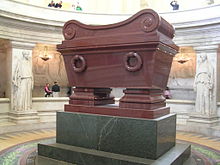
The Emperor Napoleon in His Study at the Tuileries, by Jacques-Louis David, 1812
On this day in 1821, military and political leader, Emperor of the French, Napoleon Bonaparte died in exile on the island of Saint Helena in the Atlantic Ocean at the age of 51. Born on 15 August 1769 in Casa Buonaparte in Ajaccio, Corsica. The Corsican Buonapartes originated from minor Italian nobility. Napoleon trained as an artillery officer in mainland France. He rose to prominence under the French First Republic and led successful campaigns against the First and Second Coalitions arrayed against France. In 1799, he staged a coup d’état and installed himself as First Consul; five years later the French Senate proclaimed him emperor. In the first decade of the 19th century, the French Empire under Napoleon engaged in a series of conflicts, the Napoleonic Wars, involving every major European power. After a streak of victories, France secured a dominant position in continental Europe, and Napoleon maintained the French sphere of influence through the formation of extensive alliances and the appointment of friends and family members to rule other European countries as French client states. Napoleon’s campaigns are studied at military academies throughout much of the world. The French invasion of Russia in 1812 marked a turning point in Napoleon’s fortunes. His Grande Armée was badly damaged in the campaign and never fully recovered. In 1813, the Sixth Coalition defeated his forces at Leipzig; the following year the Coalition invaded France, forced Napoleon to abdicate and exiled him to the island of Elba. Less than a year later, he escaped Elba and returned to power, but was defeated at the Battle of Waterloo in June 1815. Napoleon spent the last six years of his life in confinement by the British on the island of Saint Helena. An autopsy concluded he died of stomach cancer, although it has been conjectured he was poisoned with arsenic. Napoleon married twice; Joséphine de Beauharnais (1796-1810 divorce) and Marie Louise (1810-1821 his death). He had one biological child, a son who died without issue.
 The Final Footprint – Napoleon was initially entombed on St. Helena in the Valley of the Willows. In 1840, King of the French Louis Philippe I obtained permission from the British to return Napoleon’s remains to France. The remains were transported aboard the frigate Belle-Poule, which had been painted black for the occasion, and on 29 November she arrived in Cherbourg. The remains were transferred to the steamship Normandie, which transported them to Le Havre, up the Seine to Rouen and on to Paris. On 15 December, a state funeral was held. The hearse proceeded from the Arc de Triomphe down the Champs-Élysées, across the Place de la Concorde to the Esplanade des Invalides and then to the cupola in St Jérôme’s Chapel, where it stayed until the tomb designed by Louis Visconti was completed. In 1861, Napoleon’s remains were entombed in a porphyry sarcophagus in the crypt under the dome at Les Invalides, the burial sight for some of France’s war heroes including a memorial to Antoine de Saint-Exupéry.
The Final Footprint – Napoleon was initially entombed on St. Helena in the Valley of the Willows. In 1840, King of the French Louis Philippe I obtained permission from the British to return Napoleon’s remains to France. The remains were transported aboard the frigate Belle-Poule, which had been painted black for the occasion, and on 29 November she arrived in Cherbourg. The remains were transferred to the steamship Normandie, which transported them to Le Havre, up the Seine to Rouen and on to Paris. On 15 December, a state funeral was held. The hearse proceeded from the Arc de Triomphe down the Champs-Élysées, across the Place de la Concorde to the Esplanade des Invalides and then to the cupola in St Jérôme’s Chapel, where it stayed until the tomb designed by Louis Visconti was completed. In 1861, Napoleon’s remains were entombed in a porphyry sarcophagus in the crypt under the dome at Les Invalides, the burial sight for some of France’s war heroes including a memorial to Antoine de Saint-Exupéry.
Have your planned yours yet?
Follow TFF on twitter @RIPTFF


Pingback: Thoughts of You Between Two Visions » TeaWithTater.com